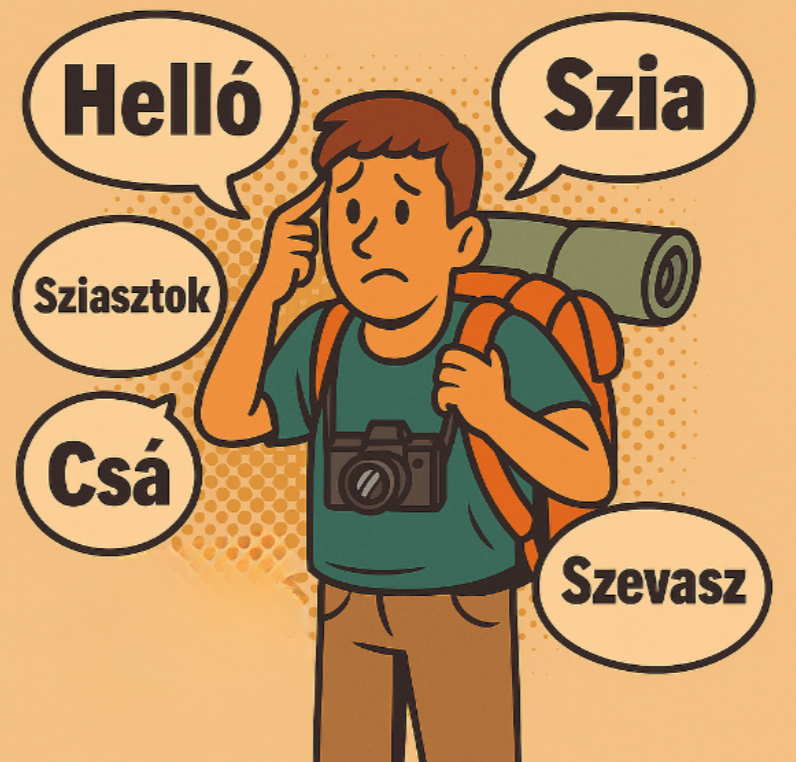Photo by: Photo by: Travel Hungary Now © – All rights reserved – Unauthorized use is prohibited.
A confused cartoon traveler with a backpack and camera stands surrounded by Hungarian greetings in speech bubbles, including “Helló,” “Szia,” “Sziasztok,” “Csá,” and “Szevasz.”
👋 How to Say Hello in Hungarian
When you visit Hungary for the first time, one of the simplest gestures you can offer is a polite “hello.” But just like the country’s thermal baths, paprika-rich cuisine, and intricate history, even a basic greeting in Hungary carries layers of meaning.
In this article, we’ll explore how to say hello in Hungarian, the cultural context around greetings, and how to make the right impression—whether you’re chatting with a new friend or checking into a hotel in Budapest.
The most common way to say “hello” in Hungarian is:
Szia (pronounced: see-ya) — used just like “hi” or “hello” in informal situations.
If you’re greeting one person in a casual setting—like a shopkeeper, a friend, or someone your age—Szia is perfect.
For two or more people, use:
Sziasztok (see-ya-stok) — the plural form of “Szia.”
🎩 Formal Greetings: When “Szia” Isn’t Enough
Hungarians place a strong emphasis on politeness and respect, especially when interacting with elders or strangers. In these cases, it’s better to use a formal greeting like:
Jó napot kívánok (pronounced: yo nah-pot kee-vah-nok)
Literally: “I wish you a good day”
This phrase is suitable when:
- Entering a shop or office
- Greeting an older person
- Beginning a formal conversation
Other formal greetings include:
- Jó reggelt kívánok – Good morning
- Jó estét kívánok – Good evening
Using these greetings properly signals cultural awareness and respect—a gesture that’s often warmly appreciated in Hungary.
🧑🤝🧑 Casual Alternatives & Slang
While “Szia” is the standard, modern Hungarian also borrows greetings from other languages:
- Helló – Yes, this borrowed word works just like in English
- Csá – Ultra casual, mostly used by teenagers
- Szevasz – Slightly dated, but still heard among older generations
Use these with peers or close friends, and avoid them in formal or unfamiliar contexts.
💡 When & How to Greet in Hungary
In Hungary, greetings aren’t just for hellos—they also shape the rhythm of everyday social interaction.
Some cultural notes:
- It’s customary to greet people when entering a shop or restaurant, even briefly.
- Eye contact and a slight nod or smile are often part of the interaction.
- Avoid waving or being overly enthusiastic in formal settings—it may come off as too casual.
In rural areas or older communities, formality can be more important than in Budapest or tourist zones.
✋ Should You Use “Szia” as a Tourist?
Yes—with care.
Hungarians are generally forgiving with tourists, but using a formal greeting (Jó napot kívánok) when in doubt is a safe and respectful choice. If someone responds with “Szia,” feel free to use it going forward.
❓FAQ: Hungarian Greetings
Q: What is the most formal way to say hello in Hungarian?
A: “Jó napot kívánok” is the standard formal greeting and translates to “I wish you a good day.”
Q: Is it rude to say “Szia” to a stranger?
A: Not rude, but informal. It’s best to use it with people your age or younger, and stick with formal greetings for strangers or older adults.
Q: Do Hungarians shake hands or bow when greeting?
A: A firm handshake is common in formal situations. Slight nods or eye contact also accompany greetings.
🧳 Final Thoughts: Start with “Hello,” Build a Connection
Learning how to say “hello” in Hungarian is more than just a language tip—it’s a gateway to cultural connection. Whether you’re walking through a Budapest market or stepping into a countryside guesthouse, offering a well-placed “Szia” or “Jó napot kívánok” can transform your interaction.
So next time you step off a tram or walk into a café, give it a try. A simple “hello” might just lead to your favorite Hungarian memory.
FAQ
How do you greet someone in Hungarian?
Hungarians typically greet each other with “Szia” (pronounced see-ya) in casual settings. For more formal situations, such as entering a shop or greeting someone older, “Jó napot kívánok” (Good day) is more appropriate. There are also greetings for specific times, like “Jó reggelt” (Good morning) and “Jó estét” (Good evening).
How do you say basic words in Hungarian?
Some of the most common Hungarian words for beginners include:
Kérem – Please
Hungarian pronunciation and word order may feel unusual at first, but the basics are easy to pick up with practice.
Szia – Hi / Bye (informal)
Köszönöm – Thank you
Igen / Nem – Yes / No
Viszlát – Goodbye (more formal)
Can “Szia” mean bye?
Yes! Just like “ciao” in Italian, “Szia” in Hungarian can mean both hello and goodbye in informal contexts. It’s commonly used among friends and family when arriving or leaving.
What does “SZIA” mean in Hungarian?
“Szia” is a friendly, informal greeting used to say hi or bye. It comes from the Latin “servus,” meaning “your servant,” and has evolved into one of the most common everyday greetings in modern Hungary.
